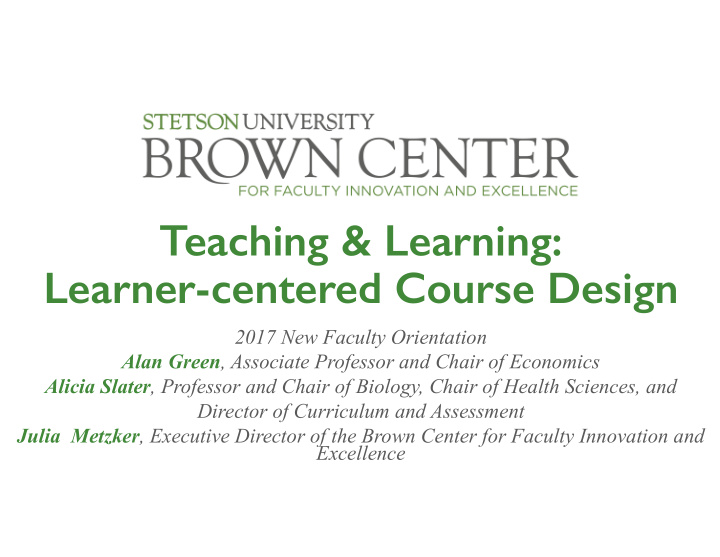



Teaching & Learning: Learner-centered Course Design 2017 New Faculty Orientation Alan Green , Associate Professor and Chair of Economics Alicia Slater , Professor and Chair of Biology, Chair of Health Sciences, and Director of Curriculum and Assessment Julia Metzker , Executive Director of the Brown Center for Faculty Innovation and Excellence
What is Teaching? A. At the collegiate level and higher, with mature students, teaching is simply the presentation of expert knowledge. B. In the current higher education landscape, teaching has been reduced to entertaining students while hoping to impart a bit of knowledge. C. A transaction; students pay for access to our expert knowledge and we provide it. D. A skill that improves with deliberate practice. E. One half of a game where students jump through required hoops in order to be certified as capable.
Welcome to your new job! • Prepare your classes! Here’s how I started: • Textbook • Material • Schedule
What’s wrong with this approach? A. The focus is on material rather than outcomes B. There is no thought to integration to the broader curriculum C. It’s an approach that centers on me, the expert, and what I can present rather than on the students and what they are learning D. I chose it because it was easy for me – it played to my strengths at the time E. I failed to converse with my senior colleagues regarding course content
Backward Course Design – Begin at the End! What are the big ideas? What are the learning outcomes?
Students will forget almost everything they are taught.
What’s the most important single thing about any classroom? A. The professor’s skill in presenting the material B. Student’s readiness to engage in class C. The content – that’s what they are paying for D. The professor’s ability to manage the classroom E. What the students are doing
If you design a course based on content… • You then focus on coverage • What students do becomes secondary • You set up a passive learning environment such as a lecture.
Most of us received an inferior education. • The best students learn very well in lectures!
If you design a course based on learning outcomes… • You ask, how can I help students meet these outcomes? • You focus on what students are doing • You create a more active classroom and more focused assignments
Why am I asking you questions via Nearpod? A. To show off B. To be annoying and slow down the presentation C. To keep you engaged D. To have everyone answer each question E. To get feedback on how well you are understanding the content
I started using clicker apps in my classes seven years ago. How do I know they are effective? A. I have empirical evidence. B. I see the looks of engagement in my students’ eyes. C. Students say how great they are. D. Exam scores improved. E. I don’t really know, I just like them.
What is a teacher-scholar? • One aspect: scholarship of teaching and learning • Consider conferences on teaching – there is support! • Develop your teaching skill – read the latest research!
Links to get you started: • http://www.learningscientists.org/ • http://cwsei.ubc.ca/resources/index.html • http://www.learningscientists.org/blog/2017/5/25-1
Big Idea What is the “big picture” or lofty idea? Goals What do you want your students to be able to do? Activities Assessment Debates, reports, experiments, Did students achieve the goals? posters, presentations, interviews, Include formative & summative essays, exams assessment. Reflect Adapted from Understanding by What worked? What can be improved? Design by Wiggins & McTighe
Recommend
More recommend